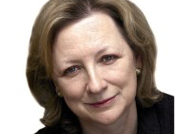Carla Carlisle on the wonder of maps
Despite her husband’s assertion that she can’t read maps, Carla confesses to a deep love of the genius of good cartography


One of the nicest things about the written word is that you get to be who you want to be. In print, I'm a size 10 fearless cowgirl with a ready wit. The truth is, I haven't been a size 10 since my wedding day and, despite pen portraits of marital wit and warmth, I often get on my husband's nerves.
One of the things about me that drives him crazy is my map reading. Lack of. He maintains that I can't read maps. I'm rather touchy about this accusation because I love maps the way some women love cookbooks. I gaze at them for hours. Old Ordnance Survey maps make me as wistful and melancholy as the poetry of Rupert Brooke. My first decorative effort as a bride was to transform a dull passageway into the Map Room. It now houses a collection of maps in their worn leather slipcases, a complete set of Baedeker's, shelves of travel books and a 12ft National Geographic map of the world (North America in centre stage is a piece of grit that has not developed into a conjugal pearl). True, I'm no good at deciphering a road atlas on the M11, and I lived in England for two years mystified by this woman called Ada Zed whom everyone seemed to know, but I think these are trivial flaws in someone who believes that the cartographer's art is up there with poets and composers.
Further in my defence, when I find myself with a free afternoon in London, I don't head for Peter Jones-I head for the map shop behind the Blewcoat School in Victoria. That's where I found the room-size maps, my giant mousemat map of the world (a constant revelation) and treasures from the Royal Geographical Society for my library of polar exploration. I'm not a woman who hankers for sights at the end of the Earth. Although I've read every word written by Scott and Shackleton, I don't yearn to visit flocks of Antarctic emperor penguins, ice-age glaciers and calving icebergs. In the church of tourism, I'm an agnostic, but I love the music and the smells, the liturgy of books and maps where there's no seasickness or disappointment, no messy money, no extremes of temperature, no disruptive modernity.
* Subscribe to Country Life and up to £50
Those were my thoughts this morning as I headed to my map shop, but instead of a window filled with guides to Mongolia and geological maps of Brazil, a single sign read: ‘The National Map Centre here in Caxton Street will be closing at the end of September.
We would like to thank all our customers for their custom over the last 60 years.' It was as if my passport had been stamped invalid. In a forlorn gesture of gratitude, I chose books (Mark Twain, Alain de Botton, Eric Newby), maps of India (who knows?) and a brass compass. As I paid, I asked the man at the till if the internet was responsible. ‘No, just the times. And a new landlord who's tripling the rent.'
On the train, I kept thinking of a short story called The Mappist by Barry Lopez, about a mapmaker in North Dakota called Corlis Benefideo. I thought of his collection of handmade maps -Mackenzie's map sketches of northern Canada; FitzRoy's coastal elevations of Chile, made during the voyage with Darwin; sketches of the Thames docks made by Pepys-and his belief that maps give a society its dignity, show how history and people fit the places they occupy.
Exquisite houses, the beauty of Nature, and how to get the most from your life, straight to your inbox.
Back home, I read the story again, looking for the passage in which the mapmaker defends his maps that show things as seemingly obscure as how the arrival of German and Scandinavian farmers changed the composition of the topsoil. ‘I've nothing against human passion, human longing,' he says. ‘What I oppose is blind devotion to progress, and the venality of material wealth.
If we're going to trade the priceless for the common, I want to know exactly what the terms are.' As the Map Centre on Caxton Street closes, I have the feeling that we are trading the priceless for the common. Because, trust me, I really can read a map.
Country Life is unlike any other magazine: the only glossy weekly on the newsstand and the only magazine that has been guest-edited by His Majesty The King not once, but twice. It is a celebration of modern rural life and all its diverse joys and pleasures — that was first published in Queen Victoria's Diamond Jubilee year. Our eclectic mixture of witty and informative content — from the most up-to-date property news and commentary and a coveted glimpse inside some of the UK's best houses and gardens, to gardening, the arts and interior design, written by experts in their field — still cannot be found in print or online, anywhere else.
